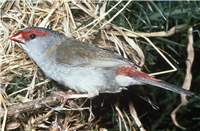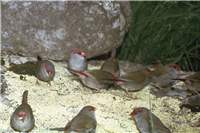Family
Passeridae
Genus
Neochmia
Species
temporalis
Threats/Control Methods - Regional
Land clearing and urban development pose the greatest threats for this species. The suburban developments on the Canberra outskirts has seen significant habitat destruction. Prolonged droughts limit the water available to vegetation, making the forests around Canberra less appealing to this species.
Threats/Control Methods - Local
Within suburban areas, free roaming domestic pets, especially Cats (Felis catus) predate this species.
Local/Urban Actions
The preservation of large areas of suitable forest areas with thick vegetation is very important. Gardeners wanting to attract these spectacular little birds should consider planting native grasses and thick native shrubs. The Red-browed finch will use bird feeders, however larger birds and more aggressive species such as the Common Myna (Acridotheres tristis ) will often be a successful deterrent to this smaller species.
Common Names
Red-browed Finch, Red-browed Firetail
Distinguishing Features
This tiny bird of 11-12cm is very noticeable due to the bright red colour of the beak, brow and rump. Its other plumage is olive green, with grey underparts. Young birds ashy-brown coloured and lack the red beak and broare.
Survey Techniques
Secure, not listed under the EPBC Act 1999.
Species Call
The Silvereye (Zosterops lateralis ) is a similar size and also has olive green plumage, however it lacks the red markings, and has a destinctive white ring around the eye.
Similar Species
The Red-browed Finch is found across the eastern Australian mainland, mostly to the east of the Great Dividing Range. More locally, the species is regularly spotted on Mt. Ainslie, Mt. Taylor and breeds along the Murrumbidgee river corridor and in surrounding forested sites.
Distribution
Australia
Country of Origin
Call and visual identification.
Conservation (Pet/Pest) Status - Regional
This species was recorded at CSIRO and the ANBG, with a few at Black Mountain Peninsula and Turner, and one at ANU.
Conservation (Pet/Pest) Status - National
This is the most common finch in the Canberra region, however population numbers fluctuate greatly from year to year (COG).
LSCCES Population
The Red-browed Finch inhabits the thick, damp undergrowth of wet eucalypt forests and will move to grassy clearings to feed. It also lives in heath, coastal scrubland, mangroves and canefields.
Associated vegetation community
This species requires thick vegetation for shelter, especially in the summer breeding season. They prefer moist environments and survive better in areas with limited threats from feral or introduced species.
Limiting Resources
The breeding season runs over the warmer months from October to April. Breeding partners share the building of the fairly large, horizontal, untidy nest of grass stems lined with small feathers. The nest is placed in thick, often thorny vegetation, 1-3 m above the ground. Both parents incubate the 4-5 small white eggs for two weeks. The young then spend 24 days in the nest. A pair may have several broods in a season.
Behaviour
These birds are highly sociable, foraging on the ground in close-knit flocks. This species moves into the forest areas surrounding Canberra in the summer for breeding.
Functional Group
Food Species
These finches forage on the ground for insects and seeds. They can also be seen feeding while perched on seed heads. Sometimes they will feed in the canopy of Allocasuarina.
Predators
Cats (Felis catus), both domestic and feral may hunt this species.
Interesting Fact
This is the only finch species known to feed in tree canopies.
References - (reader suitability of references, P=Primary teachers, S=Secondary students, T=Tertiary students and researchers)
Books: Morcombe, M. 2000. Field Guide to Australian Birds. Steve Parish Publishing. Archerfield. Australia P, S, T
Veerman, P. 2003. Canberra Birds: A report on the first 21 years of the garden bird survey. Philip Veerman and Canberra Ornithologists Group. Canberra. S, T
Internet: Birds in Backyards. 2006. [online]. Available at:http://www.birdsinbackyards.net P, S, T
Canberra Ornithological Group (COG). 2004. Birds of Canberra Gardens. COG and the ACT Department of Urban Services. [online]. Available at:http://garden.canberrabirds.org.au/ P, S, T
Online Publications:Nix, H. and Cunningham, R. 2006. Birds of the Lower Sullivans Creek Catchment, Canberra ACT. Prepared for the Life in the Suburbs project using data from the Lower Sullivans Creek Catchment Ecological Survey (LSCCES). Australian National University. Canberra. [online]. Available at: http://www.lifeinthesuburbs.com.au/category.php?id=65 S, T


 Top
Top Top
Top